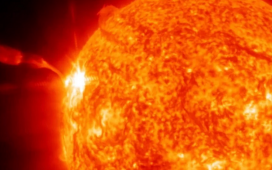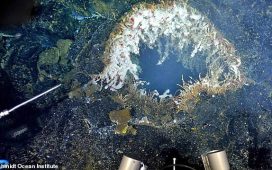It is understandable why a comet dubbed the ‘devil’ might strike fear into you.
Especially when this particular space rock is three times the size of Mount Everest and is currently exploding like a volcano on its way towards Earth.
Thankfully there’s no chance of 12P/Pons-Brooks actually hitting us, but it is expected to be visible to the naked eye when it makes its closest approach in June 2024.
That’s next year, however. What about the space rocks set to race by Earth before the end is out?
MailOnline takes a look at five of the rarest, largest and closest asteroids – as well as another comet – that stargazers can feast their eyes on over the next couple of months.

Look out! MailOnline takes a look at five of the rarest, largest and closest asteroids – as well as a comet – that stargazers can feast their eyes on over the next couple of months (pictured)
It took the enormous Chicxulub asteroid to wipe out the dinosaurs 66 million years ago.
Thankfully, NASA isn’t expecting us to meet a similar fate from space, but that hasn’t stopped it preparing a planetary defence strategy in the form of the Double Asteroid Redirection Test (DART), which proved successful last year.
So far the US space agency has discovered more than one million space rocks circling around our solar system, including 95 per cent of the asteroids that are greater than half a mile in size and at risk of coming close to our planet.
When it comes to solely the latter, there are currently more than 30,000 near-Earth objects (NEOS) identified, some of which are classified as ‘potentially hazardous’.
Among them are two we have explored below that you can catch a glimpse of next month.
The designation is given to asteroids around 460ft (140m) in diameter that will orbit within about 0.5 astronomical units (4.6 million miles) of Earth’s path around the sun.
To put that into context, the moon orbits at an average distance of around 240,000 miles, so the potentially hazardous asteroids are dangerously close in an astronomical context but not in terms of us having to worry about it.
Nevertheless, here are five asteroids to keep an eye out for and how they stack up in terms of size, speed and closeness to Earth in 2023.
139622 (2001 QQ142)
What is it?
An Apollo-class asteroid. These are space rocks which cross the orbit of the Earth and are a major source of the meteorites that occasionally hit our planet.
How big is it?
This particular space rock is thought to be between 0.2 miles (0.347km) and one mile (1.552km) in diameter, which would make it comparable in size to the Golden Gate Bridge.
It is bigger than 97 per cent of all asteroids known to be swirling around in space.

How it stacks up: This rendered image shows what 139622 (2001 QQ142) looks like in comparison to the size of Mount Everest on Earth
How long does it take to orbit the sun?
620 days
When will it come closest to us?
The asteroid will have a close flyby to Earth on December 6 at a distance of 3.4 million miles (5.5 million km).
How fast is it travelling?
14,890mph (23,900 km/h)
Is it a potentially hazardous asteroid?
Yes
341843 (2008 EV5)
What is it?
An Aten-class asteroid. They are space rocks which spend the majority of their time hidden by the sun and have orbital periods of less than a year.
How big is it?
With a diameter of 1,300ft (0.4km), this asteroid is about the size of the US Capitol building, and is bigger than 90 per cent of all asteroids.
How long does it take to orbit the sun?
343 days
When will it come closest to us?
341843 (2008 EV5) will have a close flyby to Earth five days before Christmas, on December 20, at a distance of 3.9 million miles (6.3 million km).
How fast is it travelling?
11,950mph (19,200 km/h)
Is it a potentially hazardous asteroid?
Yes

Terrifying: 341843 (2008 EV5) is about the size of the US Capitol building, astronomers say
(2019 CZ2)
What is it?
An Apollo-class asteroid
How big is it?
(2019 CZ2) is a very small asteroid. It is comparable in size to an American school bus, with a diameter estimated to be between 68ft (21m) and and 308ft (94m).
Where is it now?
(2019 CZ2) is currently in the constellation of Pisces.

Comparison: (2019 CZ2) is a very small asteroid. It is about the size of an American school bus, with a diameter that is estimated to be between 68ft (21m) and and 308ft (94m)
How long does it take to orbit the sun?
605 days
When will it come closest to us?
This asteroid will make its next closest approach to Earth on November 25, at a distance of 666,000 miles (1.1 million km).
How fast is it travelling?
13,000mph (20,900 km/h)
Is it a potentially hazardous asteroid?
No, but it is a near-Earth asteroid
2020 YO3
What is it?
An Apollo-class asteroid
How big is it?
Another small space rock, 2020 YO3 is estimated to be between 101ft (31m) and and 230ft (70m) in diameter.
This makes it an average-sized asteroid that is about the size of London’s famous landmark, Big Ben.
Where is it now?
Asteroid (NEO) 2020 YO3 is currently in the constellation of Corona Australis
How long does it take to orbit the sun?
1,100 days
When will it come closest to us?
2020 YO3 will make its next flyby of our planet a festive one. It will pass by the Earth on December 23, at a distance of 847,000 miles (1.3 million km).
How fast is it travelling?
37,180mph (59,800 km/h)
Is it a potentially hazardous asteroid?
No, but it is a near-Earth asteroid
(2013 VX4)
What is it?
An Apollo-class asteroid
How big is it?
(2013 VX4) is also on the smaller side as asteroids go, estimated to be between 144ft (44m) and and 325ft (99m) in diameter.
This is around the size of the Statue of Liberty in New York — a terrifying thought ploughing its way towards us.

Terrifying: The space rock (2013 VX4) is a very small asteroid comparable in size to the Statue of Liberty. This is how it would appear if it were to crash down on New York City
How long does it take to orbit the sun?
912 days
When will it come closest to us?
2013 VX4 will make its next closest approach to Earth on December 4, when it will race passed us at a distance of around 1.2 million miles (1.9 million km).
How fast is it travelling?
14,700mph (23,600 km/h)
Is it a potentially hazardous asteroid?
No, but it is a near-Earth asteroid
And a bonus comet…
The space rocks above are all asteroids. But what about comets similar to the ‘devil’ one expected to be visible in June 2024? Step up 144P/Kushida.
144P/Kushida
144P/Kushida is a comet discovered on January 8, 1994 by amateur astronomer Yoshio Kushida in Japan. It has an orbital period of just 7.6 years, which is short compared to other comets.
The space rock will make its closest approach to Earth on December 12, before reaching its nearest point to the sun a month later on January 25, 2024.
Although the comet reaches its maximum brightness only in 2024, stargazers in both hemispheres can catch a glimpse of it with the help of large binoculars and small telescopes by the end of 2023.
It is currently in the constellation of Aries but moving towards Earth at around 65,000 mph (105,000 km/h).

Glowing green: 144P/Kushida (pictured) is a comet discovered on January 8, 1994 by amateur astronomer Yoshio Kushida in Japan. It has an orbital period of just 7.6 years, which is short compared to other comets











